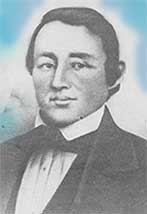Upton Hays
| Upton Hays | |
|---|---|
 | |
| Born |
March 29, 1832 Caldwell County, Kentucky |
| Died |
September 15, 1862 (aged 30) Newtonia, Missouri |
| Allegiance |
|
| Service/branch |
|
| Years of service | 1861–62 |
| Rank |
|
| Battles/wars |
American Civil War - Battle of Carthage - First Battle of Independence - Battle of Lone Jack |
Upton Hays, sometimes spelled Hayes, (March 29, 1832 – September 15, 1862) [1] was a colonel of the Confederate States Army during the American Civil War.
Early life, career, and border warfare
Upton Hays was born in Caldwell County, Missouri. His father was Boone Hays, and his great-grandfather was famed explorer Daniel Boone. Boone Hays settled in Jackson County, Missouri in 1837, later taking his sons to California in 1850 during the gold rush, but he died of pneumonia during the trip. Upton never received any formal education.[2]
Boone Hay's sons returned to Missouri, where Upton married Margaret Jane Watts on February 4, 1852, in Jackson County near Westport. There he farmed and served as a wagonmaster and freight hauler. Upton owned one slave of his own, and managed six others for his mother-in-law, Elizabeth Watts.[2] Hays was associated with the Border Ruffians, including the future guerrilla leader William Quantrill during the Bleeding Kansas era of cross-border warfare.[2] He voted for John C. Breckenridge for president and Claiborne Fox Jackson for governor in the election of 1860.[3]
Civil War service
At the outbreak of the Civil War, Upton joined the Missouri State Guard as the captain of a cavalry company. He served in the 1861 Battle of Carthage. He and noted guerrilla Dick Yager conducted a raid against Gardner, Kansas, on October 2, 1861, as part of the cycle of cross-border raids by Jayhawkers and Border Ruffians. By December, Hays' own home had been burned.[4] He was elected lieutenant colonel of the 1st Cavalry Regiment, VIII Division, Missouri State Guard, in December 1861.[5]
In June 1862, Hays led a recruiting detail back into Western Missouri. He skirmished with pursuing Federals and dislocated his shoulder, forcing him to disperse his command for a time.[6] On July 30 Hays, with bushwhacker Dick Yager and several others, went to Westport looking for several Northern informants. In Westport they killed a discharged German-American soldier and took a large United States flag that was in the care of a local resident.[7][8][9]
At the First Battle of Independence in August 1862, Upton assumed command following the death of Brigadier General John T. Hughes and the wounding of Colonel Gideon W. Thompson. The battle resulted in a Confederate victory, though the Southerners were unable to follow up on their triumph in any significant way.
Colonel Hays led the main attack at the Battle of Lone Jack. Other Confederate commanders on the scene complained that his attack was unnecessarily delayed, and therefore lost the crucial element of surprise.
Following the victory at Lone Jack, the Confederate forces withdrew closer to Arkansas for supplies. Near Newtonia, Missouri, on September 12 [10] or 15, Colonel Hays attempted to personally drive in some Union pickets and was killed instantly by a bullet to the head. According to one participant, he had been elected colonel of his consolidated regiment the day before.[11]
References
- ↑ Petersen, Richard C.; Lindberg, Kip A.; McGhee, James E.; & Daleen, Keith I.;Sterling Price's Lieutenants, Rev. ed., 2007, Two Trails Publishing, page 357, note 545, gives approx. date of death
- 1 2 3 Watts-Hays Letters 1849-1861
- ↑ Eakin, Joanne Chiles, Battle of Independence, August 11, 1862, Two Trails Publishing, 2002, page 37
- ↑ Watts-Hays Letters 1861-65
- ↑ Petersen, Richard C.; Lindberg, Kip A.; McGhee, James E.; & Daleen, Keith I.;Sterling Price's Lieutenants, Rev. ed., 2007, Two Trails Publishing, page 357, note 545
- ↑ Nichols, Bruce, Guerrilla Warfare in Civil War Missouri, 1862, McFarland & Company, 2004, page 109
- ↑ Eakin, Joanne Chiles, Battle of Independence, August 11, 1862, Two Trails Publishing, 2002, page 107 local newspaper account
- ↑ Watts-Hays Letter 40
- ↑ Nichols, Bruce, Guerrilla Warfare in Civil War Missouri, 1862, McFarland & Company, 2004, page 152
- ↑ Watts-Hays Letters 1861-65 interprets the date of death as September 12
- ↑ Eakin, Joanne Chiles, Battle of Lone Jack, August 16, 1862, Two Trails Publishing, 2001, page 63-4, "Captured Guns of at Lone Jack, Missouri" by John S. Kritser